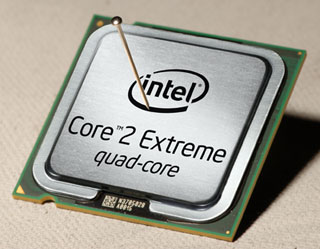Intel Core 2 Extreme QX9770 Performance Preview
Thirty million transistors on the head of a pin. Think about that for a minute. Where on earth can you fit 30 million of anything in that amount of space? It used to be that 30 million transistors was a good-sized chip. These days, in a 45nm Hafnium-based High-K process, it almost seems like we (OK, OK, Intel...) can defy the laws of physics. We're talking rocket science here people. Actually, it's probably a bit more complex than rocket science. Titanium (Ti), Zirconium (Zr), Gallium (Ga), heck we've even heard of Rubidium (Rb), but Hafnium? Is someone at Intel just making this stuff up?
|
|
Whether you fancy yourself a scientist that can appreciate naturally occurring isotopes utilized in leading-edge manufacturing processes, or maybe you're a gear-head that knows four cores running at 3.2GHz is just "freakin' fast" - there is no denying that Intel is completely unstoppable currently, when it comes to semiconductor process and manufacturing R&D. No other semiconductor company in the world is shipping anything in high volume at 45nm. That's 45 nanometers or .045 micron if you prefer. Sure, 45nm has been "demonstrated" by the likes of IBM, TSMC, and Charter Semiconductor but getting to volume is a completely different ball of wax altogether. Few companies have the resources and capital that Intel has to bring the technology to market first. And when it comes to processors comprised of 800 million plus transistors, every tenth of a micron counts.
Let's do some quick math, since we're feeling all smart and scientific. The new 45nm Intel Yorkfield processor that we'll be showing you today has a die size that measures about 214mm square and is comprised of about 820 million transistors. Comparatively, AMD's Athlon 64 X2 6000+, that is built on a 90nm process, is comprised of some 227 million transistors and has a die size of 218mm square. So we have a 45nm-built processor with four times as many transistors and 2X the number of cores on board, that is actually slightly smaller than the other with one quarter the number of transistors and half as many CPU cores. Not to mention both of these processors have comparable power consumption and thermal profiles.
To coin a John Madden-ism, "speed kills". And with processors, smaller die geometries simply bring lower cost and lower power consumption along with killer speed. In the world of semiconductors and high-end desktop CPUs, it can be said that "process kills". Today Intel is previewing the world's first 3.2GHz quad-core X86 processor. Why? Because they can. Though the Core 2 Extreme QX9770 will not be available for sale until Q1 2008, we've had the chip in-house at HotHardware for the better part of a month. In the pages ahead we'll show you how a 45nm quad-core processor can stretch its legs. Scientists, Physicists and Gear-Heads take note, Intel is jacked up on Hafnium and is breaking out past the 40, heading for the end-zone.
|
|
|
|
|
If you're familiar with the basic chip-level architecture of Intel's 45nm Yorkfield core quad-core processor that we showed you a few weeks back in our Core 2 Extreme QX9650 launch piece, then you've probably noticed that the new QX9770 model is simply a "speed bump" of sorts. Although the QX9770 represents a speed bump on couple of levels, not just core processor speed. Intel is taking the processor to 3.2GHz not by increasing the bus multiplier of the chip, rather they are raising the front side bus speed to 1600MHz, which in turn also provides additional system bus and memory bandwidth.
We've published a number of articles relating to Intel's Core microarchitecture, Core 2 Duo and Extreme family of processors, Penryn, and Intel's 45nm manufacturing process in the past here at HotHardware. For more detail or a refresher on the technologies employed in these products, we suggest taking a look at the following related articles.
- Intel Skulltrail and Penryn Performance Preview
- Intel P35 Bearlake Chipset and DDR3 Memory Launch
- Intel Core 2 Extreme QX6850
- Intel Penryn and Nehalem Details Emerge
- Intel Wolfdale and Yorkfield Performance (Penryn)
- Intel 45nm Fab Process And Penryn Preview
The Intel 45nm Fab Process and Penryn previews above are probably most valuable material if you want to get familiar with the new technologies employed in the Yorkfield core that is at the heart of the new QX9770. These articles will give you a solid background for understanding the underlying technologies of the new Intel processor we'll show you in the pages ahead.








